b by J.B. Wood | Contributing Editor
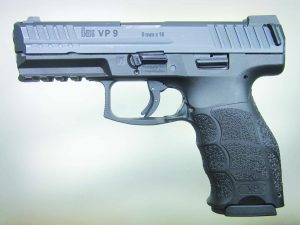
The H&K VP9 pistol seen from the left side.
This seems to be the age of the polymer-frame striker-fired pistol. The US Military even adopted one, recently. One of the advantages of this type is that with the action parts in a sub-frame, the grip-frame can vary, drastically. It can be tailored for different hand sizes, made into a compact, and so on.
About two years ago, the Heckler & Koch entry had several interesting differences. In one of them, H&K took the adjustable grip-frame to a new level. The VP9 has not only three sizes of back-strap inserts; it also has inserts for the side-panels, to accommodate larger hands.
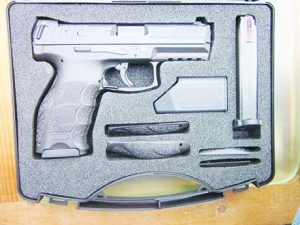
The kit includes a nice magazine loader.
Another neat H&K addition: Small flanges at the rear edge of the slide, a great help in cycling. The manual calls them “charging supports.” Their protrusion is minimal, and they are of considerable advantage for anyone with a weaker grip. However, if you don’t need them, and would prefer a flat slide in that area, H&K can supply non-protruding inserts.
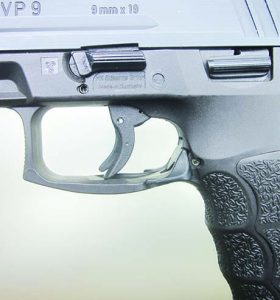
The left-side controls: Takedown latch, slide latch, magazine release.
Most designers today go with a push-button magazine release. They work fine. But, on rare occasions, body motion and a tight holster can slightly depress one, leaving the magazine partly out (or ejected!). With the one on the VP9, this can’t happen. At the lower rear of the trigger guard, on both sides, pushing the lever downward will free the magazine.
Quite a few years back, the police chief of a small city asked me why his officers, who were shooting well at the range, consistently grouped to the left. After observing them at practice, I advised him to tell them: “Get the finger off the front of the trigger guard. Cup the support hand underneath.” That solved the problem.
Even so, for those of you who have managed to use that hold without grouping left, the VP9 has a straight front to the guard, with cross-grooving. Just ahead of that, there’s a standard rail for a light or laser. On the front-strap of the grip-frame, there are shallow recesses for all three fingers of the shooting hand.
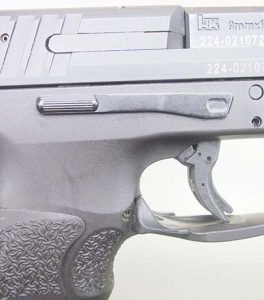
The right-side slide latch has good leverage.
In addition to the twin magazine release levers, the VP9 is also friendly to left-handers with the slide latch. On the right side, the lever is very long, with good mechanical advantage for easy operation. There is no magazine disconnect safety. With the mag out, you can still fire a chambered round.
Internally, there’s a striker-block safety that is always “on,” and is cleared only in the last little bit of trigger-pull. In the trigger, there is one of those stupid little “flipper” safety levers. Well, this one, at least, is not side-to-side loose—it’s nicely fitted. After a while, you don’t notice it.
In striker-fired pistols of this type, manufacturers, and even some firearms writers, often have difficulty in naming the trigger system. Here are the proper terms: If the striker is at full forward rest, and the trigger pull takes it all the way back, then releases it to fire, that’s a true “Double-Action-Only.” If cycling the slide leaves the striker in a “half-cocked” mode, then you might call it a “semi-DAO.”
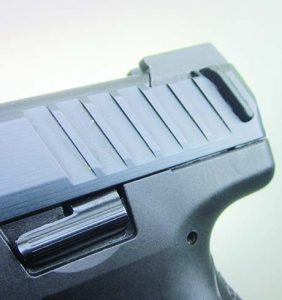
The “charging supports” at the rear edge of the slide have minimal protrusion, but they are a great help.
In the VP9, a slide cycle places the striker in fully-cocked position. So, mechanically, it’s a single-action system, with a sort of double-action trigger. In the first part of the pull, about 3/16 of an inch, you are only softly compressing the trigger spring. Then, when the trigger bar engages the sear, you get a nice let-off, 5.5 pounds on the test gun. Over-travel was minimal.
Most double-column magazines have cartridge-count holes in the back that are alternate, left to right. On the VP9 magazine, the holes are in a straight line, numbered 4 to 15, easier to read. A large floor plate protrudes slightly, to insure positive seating* As the numbering tells you, capacity is 15 rounds.
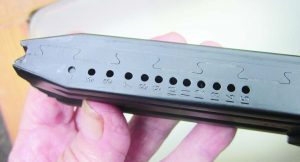
The cartridge-count holes on the back of the magazine are in a straight line, numbered 4 to 15.
The other numbers: Weight, empty, 26.56 ounces. Length, 7.34 inches. Height, 5.41 inches, and width, 1.32 inches. Barrel length is 4.09 inches. This is the regular VP9, the one shown here. It is the full-sized version, not for deep concealment, but fine for house or car.
The sights are the usual three-dot square-picture type, and both front and rear can be moved laterally in their dovetails. Both are steel, not polymer. The external front edge of the rear sight has an inward bevel. So, if a one-hand slide cycle is necessary, you can use it against a belt or other surface.
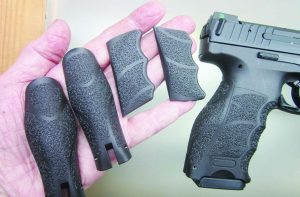
You get not only backstrap inserts, but also alternate side panels
At the range, the VP9 did well. Whether standing, two-hand hold at 7 yards, or at 15 yards from a casual rest, it printed well-centered groups of 3 to 3.5 inches. Functioning was perfect and felt-recoil light. The after-shooting takedown for cleaning is particularly easy.
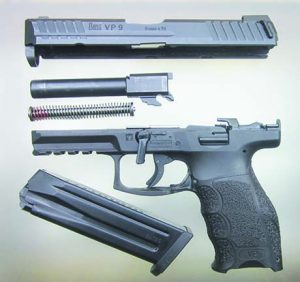
The H&K VP9, field-stripped. Easy takedown.
In the past year, H&K has also offered the pistol as the VP40, chambered for the .40S&W. More recently, there have been compact versions, and a “tactical” one, with threaded barrel for a suppressor. The original VP9, shown here, has an MSRP of $719, but a recent ad from a store in my area listed it at $580.
Any other questions? Here’s the contact data: Heckler & Koch, 5675 Transport Blvd., Columbus, GA 31907. Phone: 706-568-1906; Online: hk-usa.com



